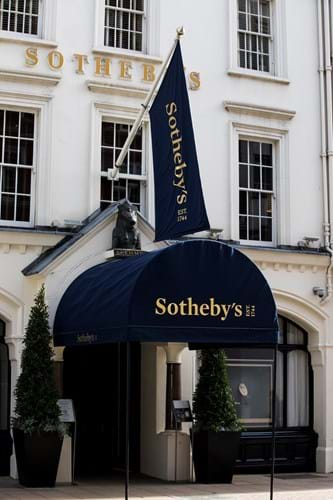The new charges will come into effect in May.
Among the headline changes, Sotheby’s is abandoning its current three-tiered buyer’s premium structure and switching to a simpler two-tiered format. The new rates will be 20% on the hammer price up to $6m/£5m, and 10% of the hammer price above $6m/£5m.
This means Sotheby's premium will be lower than that charged by many regional UK and US salerooms and significantly below the fees charged by its principal market rivals.
Previously the fees at Sotheby's were 26% up to $1m/£800,000, then 20% up to $4.5m/£3.8m, and then 13.9% on the portion of the hammer price beyond those levels. Since 2020 the company also charged an additional 1% administrative fee applied on the hammer price of all individual lots (the so-called ‘overhead premium’) that has now been scrapped.
Seller’s commission
Sotheby’s key changes for sellers includes the introduction of a uniform seller’s commission rate of 10% on the first $500,000/£500,000 of the hammer price per lot. There will be no seller’s commission on the portion of the hammer price above $500,000/£500,000.
Sellers of higher value consignments will not have to pay any commission at all where the low estimate is above $5m (£4.5m). When it is between $20m-$50m/ £18m-45m sellers will also receive 40% of the buyer’s premium in addition to the hammer price. For lots estimated at above $50m/£45m the arrangement is ‘bespoke’. These new fees publicly reflect the sort of arrangement that was previously commonly agreed in private.
Sotheby’s is also officially implementing a new ‘success fee’ of the type that Christie’s introduced to its vendor’s terms a decade ago. Whenever the hammer price of the lot exceeds the top estimate, Sotheby’s will receive an additional 2% commission.
The moves are remarkable on a number of counts.
Buyer’s premium ‘creep’ – that brought fees to 26% and more in the London and New York salerooms – has been a familiar if controversial feature of the fine art auction business for four decades. This is the first time since 1982 (when Christie’s briefly dropped its premium from 10% to 8%) that one of the world’s leading auction houses has reduced its buyer’s premium.
There is also now clear water between Sotheby’s and Christie’s (with its multi-tiered structure beginning at 26%) and Bonhams (a similar structure opening with a 28% fee). The firms have broadly kept their buyers’ charges in line with each other ever since the buyer’s premium was controversially introduced in the 1970s (previously the salerooms only charged vendors' commissions).
Seeking clarity
Sotheby’s said the changes follow “consistent feedback from buyers seeking lower premiums and sellers seeking clarity on selling fees”.
The auction house added: “For buyers, this new fee structure will not only make it simpler, it will also reduce the amount of buyer’s premium on the vast majority of lots. This in turn will benefit sellers by incentivising more bidding from clients which should drive up hammer prices.” Sotheby’s estimates that the average sold lot will incur 26% less buyer’s premium than before.
As a general rule, buyer’s premiums have risen so that vendor’s fees can fall. Vendors of high-value items rarely pay full commission.
Part of the reason for the sellers’ changes is to move away from the private and often complex negotiations in securing works for sale. Sotheby’s said it was prioritizing “transparency and simplicity” in this regard.
Sotheby’s chief executive officer Charles Stewart said: “Since 1979, when Sotheby’s first introduced buyer’s premium in our salerooms, the market has largely shifted the transaction burden onto buyers. The result has been high costs for buyers and tiered commission structures that require a calculator to even understand, as well as an entirely opaque fee structure for sellers which distracts from what is most important to them”.
Guarantee exempt
The changes to seller’s fees do not apply to works offered with a guarantee. Such works, which the firm said now accounts for “the majority of Sotheby’s auction business”, will carry a fixed fee of 4% of the guaranteed amount, chargeable to the seller.
The new fee structure comes into effect globally on May 20. It will apply to all auctions, excluding sales of cars, real estate, wine and spirits. Consignments signed after April 15, 2024 for auctions on or after May 20, 2024 will reflect the new terms for sellers.
Buyer’s Premium comparisons
Sotheby’s (from May 20)
20% up to £5m/$6m
10% on portion of hammer price above £5m/$6m
Christie’s (current)
26% up to £800,000/$1m
21% £800,000 to £4.5m/$1m to $6m
15% over £4.5m/$6m
Bonhams (current)
28% up to £40,000/$50,000
27% £40,000 to £800,000/$1m
21% £800,000 to £4.5m/$6m
14.5% over £4.5m/$6m
Phillips (current)
27% up to £800,000/$1m
21% £800,000 to £4.5m/$1m to $6m
14.5% over £4.5m/$6m






